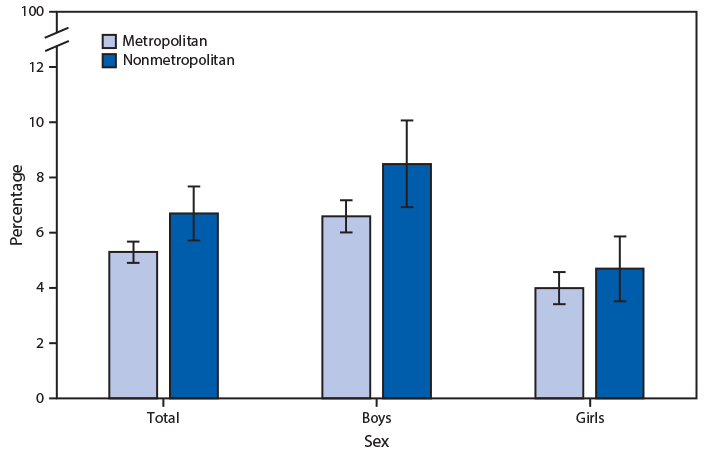QuickStats: Percentage* of Children and Adolescents Aged 4–17 Years with Serious Emotional or Behavioral Difficulties,† by Sex and Urbanization Level§ — National Health Interview Survey, 2016–2018¶
Weekly / March 13, 2020 / 69(10);276

* With 95% confidence intervals indicated by error bars.
† Serious emotional or behavioral difficulties is determined by parents’ response of “yes, definite difficulties” or “yes, severe difficulties” to the survey question “Overall, do you think that (child) has difficulties in any of the following areas: emotions, concentration, behavior, or being able to get along with people?“
§ Urbanization level is based on the Office of Management and Budget’s February 2013 delineation of metropolitan statistical areas (MSAs), in which each MSA must have at least one urbanized area of ≥50,000 inhabitants. Areas with <50,000 inhabitants are grouped into the nonmetropolitan category.
¶ Estimates are based on household interviews of a sample of the civilian, noninstitutionalized U.S. population and are derived from the National Health Interview Survey’s Sample Child component.
During 2016–2018, the percentage of children and adolescents aged 4–17 years with serious emotional or behavioral difficulties was higher among those living in nonmetropolitan areas (6.7%) than among those living in metropolitan areas (5.3%). Among boys, those living in nonmetropolitan areas (8.5%) were more likely to have serious emotional or behavioral difficulties than those living in metropolitan areas (6.6%), but the difference among girls was smaller and not significant. Among children and adolescents living in either metropolitan or nonmetropolitan areas, boys were more likely than girls to have serious emotional or behavioral difficulties.
Source: National Health Interview Survey, 2016–2018. https://www.cdc.gov/nchs/nhis/index.htm.
Reported by: Jessly Joy, oys4@cdc.gov, 301-458-4836; Deepthi Kandi, MS.
Suggested citation for this article: QuickStats: Percentage of Children and Adolescents Aged 4–17 Years with Serious Emotional or Behavioral Difficulties, by Sex and Urbanization Level — National Health Interview Survey, 2016–2018. MMWR Morb Mortal Wkly Rep 2020;69:276. DOI: http://dx.doi.org/10.15585/mmwr.mm6910a6external icon.
MMWR and Morbidity and Mortality Weekly Report are service marks of the U.S. Department of Health and Human Services.
Use of trade names and commercial sources is for identification only and does not imply endorsement by the U.S. Department of
Health and Human Services.
References to non-CDC sites on the Internet are
provided as a service to MMWR readers and do not constitute or imply
endorsement of these organizations or their programs by CDC or the U.S.
Department of Health and Human Services. CDC is not responsible for the content
of pages found at these sites. URL addresses listed in MMWR were current as of
the date of publication.
All HTML versions of MMWR articles are generated from final proofs through an automated process. This conversion might result in character translation or format errors in the HTML version. Users are referred to the electronic PDF version (https://www.cdc.gov/mmwr) and/or the original MMWR paper copy for printable versions of official text, figures, and tables.
Questions or messages regarding errors in formatting should be addressed to mmwrq@cdc.gov.